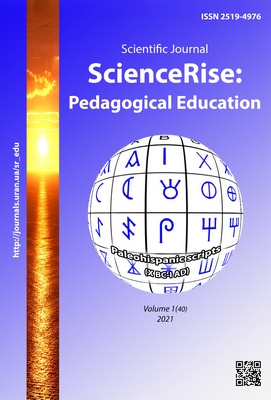Aims setting process of pre-service primary school teachers’ foreign language communicative competence development
DOI:
https://doi.org/10.15587/2519-4984.2021.224291Keywords:
aims setting, professional training, development process, foreign language communicative competence, pre-service primary school teachersAbstract
The article highlights the features of aims setting process of pre-service primary school teachers’ foreign language communicative competence development, which is based on the definition of the purposes in accordance with the peculiarities of future professional activity. This process is one of the main educational categories and reflects the features of the educational process and the results of professional training of intending primary school teachers.
The paper focuses on the views of Ukrainian and foreign scientists on the types of aims and their functions in the future teachers’ training.
This work aimed to outline the features of the aims setting process and to determine the purposes of pre-service primary school teachers’ foreign language communicative competence development.
The process of determining the purposes of education is to form a system of general scientific and special professional knowledge that provides certain skills of intending primary school teachers. It is noted, that the main requirements for formulating the aims of the educational process are: clarity, hierarchy and diagnostics.
The competence orientation to general (broad sphere of life), special (narrow sphere of activity) and subject (certain courses) determines three stages of designing the aims of intending primary school teachers’ foreign language communicative competence formation: establishing strategic (general) aim, concretizing it in tactical purposes and forming operational objectives. Tactical purposes are represented by a set of cognitive, developmental and implementation ones, which are specified by operational objectives. To schematically depict the hierarchy of the aims for the pre-service professionals’ foreign language communicative competence development, the method “Aim Tree” was used, which allows to display the hierarchical structure of the aims by dividing the overall aim (level 1) into subaims (level 2), which in turn are divided into new sub-aims (level 2)
References
Lazareva, T. A. (2014). Teoretychni i metodychni zasady pidhotovky maibutnikh inzheneriv-tekhnolohiv kharchovoi haluzi do tvorchoi profesiinoi diialnosti. Kharkiv, 625.
Halliday, M. A. K.; Webster, J. J. (Ed.) (2016). Aspects of Language and Learning. New York: Springer Heidelberg, 148.
Konovalenko, T. V., Goncharova, О. А. (2018) Future English Language Teachers' Life Skills Development in Methodology Course. Studies in comparative education, 1, 98–104.
Levytes, D. H. (2016). Avtodydaktyka. Shkolnie tekhnolohyy, 5, 101–106. Available at: https://rucont.ru/efd/589600
Radkevych, V. O. (2016). Teoretychni ta metodychni zasady rozvyku profesiioi osvity i navchannia: rezultaty, problemy, perspektyvy. Naukovyi visnyk Instytutu profesiino-tekhninoi osvity NAPN Ukrainy. Profesiina pedahohika, 11, 5–22.
Nikolaieva, S. Yu. (2016). Mizhkulturna inshomovna osvita v Ukraini: kliuchovi problemy. Inozemni movy, 86 (2), 3–9.
Metodychni rekomendatsii shchodo rozroblennia standartiv vyshchoi osvity. Available at: https://law.chnu.edu.ua/metodychni-rekomendatsii-shchodo-rozroblennia-standartiv-vo/
Malafiik, I. V., Kryvko, M. P. (2016). Yednist upravlinskoho ta dydaktychnoho tsykliv yak osnova formuvannia subiekta navchalnoho piznannia. Onovlennia zmistu, form ta metodiv navchannia i vykhovannia v zakladakh osvity, 13 (56), 113–116.
Klarin, M. (2016). Conceptual challenges in understanding innovative education in organizational context. International Journal of Cognitive Research in Science, Engineering and Education, 4 (1), 67–71. doi: http://doi.org/10.5937/ijcrsee1601067k
Androshchuk, I. V. (2017). Teoretychni i metodychni osnovy pidhotovky maibutnikh uchyteliv trudovoho navchannia ta tekhnolohii do pedahohichnoi vzaiemodii u profesiinii diialnosti. Kyiv, 641.
Bloom, B. S. (1956). Taxonomy of Educational Objectives, the classification of educational goals: Handbook I. The Cognitive Domain. New York: David McKay, 207. Available at: http://www.psy.gla.ac.uk/~steve/best/bloom.html Last accessed: 26.02.2019
Radkevych, O. (2021). Communication in project activities of the teaching staff in vocational education institutions. Professional Pedagogics, 2 (21), 129–136. doi: http://doi.org/10.32835/2707-3092.2020.21.129-136
Marihodov, V. K. (2014). Metody zakhystu navchalnoi informatsii v merezhakh dystantsiinoi osvity. Novi tekhnolohii navchannia, 80, 179–182.
Koshuk, O. B. (2017). Kontseptualni aspekty tsilespriamovanoho formuvannia profesiinoi kompetentnosti maibutnikh inzheneriv z mekhanizatsii silskoho hospodarstva. Suchasni problemy ta perspektyvy rozvytku psykholohii i pedahohiky. Kyiv: Tavriiskyi natsionalnyi universytet imeni V. I. Vernadskoho, 95–98.
Downloads
Published
How to Cite
Issue
Section
License
Copyright (c) 2021 Тамара Ивановна Бондарь

This work is licensed under a Creative Commons Attribution 4.0 International License.
Our journal abides by the Creative Commons CC BY copyright rights and permissions for open access journals.
Authors, who are published in this journal, agree to the following conditions:
1. The authors reserve the right to authorship of the work and pass the first publication right of this work to the journal under the terms of a Creative Commons CC BY, which allows others to freely distribute the published research with the obligatory reference to the authors of the original work and the first publication of the work in this journal.
2. The authors have the right to conclude separate supplement agreements that relate to non-exclusive work distribution in the form in which it has been published by the journal (for example, to upload the work to the online storage of the journal or publish it as part of a monograph), provided that the reference to the first publication of the work in this journal is included.








